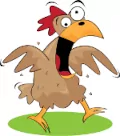Chicken math explained with real examples.

Chicken math is a phenomenon that plagues backyard chicken keepers like me, and it's a bit like trying to calculate the number of feathers on a chicken's backside – it's all very fuzzy!
What is chicken math?
Chicken math has nothing to do with teaching chickens to count. Chickens can't learn math and there is no point trying to teach them.
Chicken math is how backyard keepers count their chickens as the numbers increase year on year with each new hatch and flock additions. So the chicken keeper who starts with 5 hens in their yard and then adds a few coloured eggs layers and then some ducks and Guinea fowl.
Chicken math is the curious and incomprehensible process by which a flock of 5 backyard chickens grows to become 35 in three years.
Don't get me started on chicken coop expansions. I started with a modest little coop, but now I'm drawing up blueprints for a chicken mansion with a spa and a gourmet kitchen. And of course, every new chicken needs its own roost and nesting box, right?
Below: Chicken math stretches the meaning of "A few" to it's very limits. This is a just a few chicks, honey.
Chicken math can also be applied to chicken coops and incubators. This involves a single coop mysteriously becoming two or the magical appearance of a second incubator.
Below: For example this is 6 or 7 chickens, it's impossible to count them accurately as they keep moving around!
I am pretty sure that every long suffering partner of a chicken keeper has heard something like:
"Honey, I couldn't leave the last two chicks in the bins at Tractor Supply, they looked so lonely"
Or
" More chicks hatched than I thought would"
So, picture this: I start with three adorable little chicks, and I think to myself, "Three should be enough for fresh eggs, right?" But then, I stumble upon a feed store having a sale, and they have these cute, irresistible fluffy-butted chicks, and I'm like, "Well, maybe just two more won't hurt." So, I get those two.
But wait, there's more! A friend mentions they have some spare chicks because their neighbour's cousin's uncle's friend couldn't keep them, and they're practically giving them away. So, of course, I take three more, because, you know, they need a loving home.
Now, I have eight chickens, and I think, "I've got plenty of eggs." But then I learn about different breeds with unique plumage and quirky personalities. Before you know it, I've got a spreadsheet of breeds I want to try, and I'm scouring the internet for rare, exotic chickens like they're Pokémon!
The rules of chicken math:
Every keeper has a slightly different take but these are general rules to get you started.
- Bantams only count as 1/3 of a whole chicken.
- Hatching eggs aren't included.
- Chicks don't count towards the total.
- Older hens are only counted as three quarters as they don't lay as many eggs.
- It doesn't matter how many roosters you have, they counts as 1.
- Hens that are not in lay don't count to the total.
- Other breeds don't get added in to the total, duck math is a whole other story.
Below: You might think you can see three roosters in this picture but there is actually only one.

And because they are bantams, there is only two chickens here.
